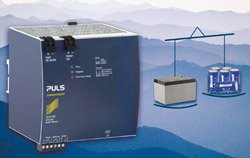
Posted to News on 13th May 2019, 19:39
Benefits of capacitor-based uninterruptible power supplies
Michael Raspotnig, a Senior Design Engineer with PULS Power, discusses the advantages of using capacitor-based power buffer modules instead of traditional lead-acid batteries for industrial uninterruptible power supplies.

For many years, lead-acid batteries have been used almost exclusively in DC-UPS systems for industrial systems. However, users have had to deal with the disadvantages of the limited lifetime, restricted temperature range and high weight of such batteries.
The recent lowering price trend in Electrochemical Double Layer Capacitors (EDLC) can make them an attractive alternative in many applications. Electrochemical Double Layer Capacitors, also known as Ultracaps, Supercaps or Greencaps, have been available on the market for more than 15 years and have proven to be a well-known and reliable component. Initially expensive, these components were unsuitable as energy storage devices in DC-UPS applications but were reserved for other applications such as energy storage for regenerative braking systems or for providing short peak currents. However, the standard price for these capacitors has almost halved in the last five years, which now makes it possible to use them as energy storage devices in DC-UPSs.
Comparing the buffer times of capacitor and battery-based systems does not achieve any meaningful purpose. Batteries always win when energy densities are compared. It is much more important to take the actual required buffer time into account. If this is between 15 and 150 seconds, then EDLC capacitors can compete on price and at the same time still demonstrate many advantages.
Key advantages are:
- Low weight
- Absolute freedom from maintenance
- No follow-up costs
- Short charging time
- No disposal of batteries
- Regulated output voltage in buffer mode
In addition, there are numerous other benefits.
Lifetime - a false sense of security?
Lead-acid batteries have a very limited lifetime. The 'long lifetime' frequently stated according to Eurobat is misleading. This applies only under ideal conditions, typically 20degC ambient temperature, and does not take into account aging of the battery occurring during storage. Temperature has the greatest influence on the reduction in lifetime. Increasing the temperature by 10degC halves the stated life. If one also does not consider the aging by storage, then a 6-9 year lifetime battery, according to Eurobat, quickly becomes one which requires replacement after only 1.5 years when taking these effects into account
These problems are eliminated when using Electrochemical Double Layer Capacitors. The capacitors are permanently installed in the device and cannot be replaced and have the same lifetime expectancy as the power supply unit itself when the buffer module is correctly designed. In practice, this is longer than 10 years in a typical application.
The storage time of Electrochemical Double Layer Capacitors is practically unlimited. They do not have to be recharged regularly and do not cause any issues if an installation should be put into service after a lengthy storage period.
Full power between -40 and +60degC
Electrochemical Double Layer Capacitors are not affected by cold and can tolerate temperatures down to -40degC. This makes these components useful for applications outdoors, in mobile systems and applications in solar or wind energy projects. With lead-acid batteries, the hydrogen freezes on charging at temperatures below -10degC and damages the battery. Only expensive pure lead batteries are suitable for such applications.
Electrochemical Double Layer Capacitors provide their full capacity even up to +60degC, which makes it possible to use them inside an enclosed non-ventilated switchgear cabinet. With lead-acid batteries hydrogen typically escapes at temperatures greater than +45degC, which creates a destructive process or can cause an explosion. It is not without reason that installing lead-acid batteries outside switchgear cabinets is recommended. In contrast to lead-acid batteries, Electrochemical Double Layer Capacitors emit no hydrogen and there is no need to ventilate the switchgear cabinet as is required by EN 50272-2 for lead-acid batteries.
New units - Wh, kWs or kJ
The capacitor voltage is reduced continuously on discharge. Therefore, stating the energy in Ah (ampere-hours), as is the practice for batteries, makes no sense and so the energy is stated in Wh (watt-hours) or in kWs (kilowatt-seconds). It is also frequently stated as kJ (kilojoule). 1kJ corresponds exactly to 1kWs. 1kWs means that the device can supply 1kW for one second or 100W for 10 seconds. The energy in a capacitor is calculated according to the following formula: Energy (Ws) = 1/2 CU2. This describes the energy to completely discharge to zero volts. However, in practice, the converters cannot work down to zero volts, so one cannot use the full energy. Caution is therefore required here: the buffer modules are classified according to their nominal energy and not according to the usable energy. When determining the buffer time, always use the data sheets or diagrams and not the simple equation stated above.
PULS offers two buffer modules with different storage capacities; the UC10.241 with 6kWs storage capacity and the UC10.242 with 12kWs. These devices are designed for 24V DC systems and can be used in the normal mode and in the buffer mode with up to 15A. In both devices, the capacitor storage unit is installed together with the electronic controls in a compact housing for DIN-rail installation. Smaller buffer modules with shorter buffer times and a 48V version are also available. The series connection of the single capacitors is equipped with an active balancing circuit, which provides long lifetime for the capacitors. The device is equipped with signalling contacts and display elements for monitoring and diagnostics. If buffering is not required, it can be disabled with the inhibit input.
More information about capacitor-based buffer modules can be found at www.pulspower.com.






























